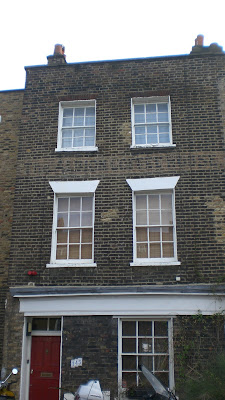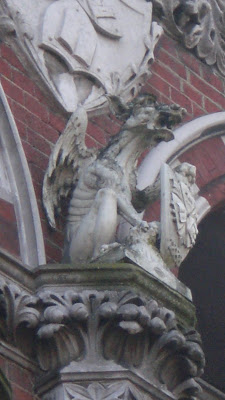The walk was about 7.6 miles in all according to Google maps (I've plotted my rough route on there as well) and I can't say it was as interesting as I hoped it might be. To summarise, the first bit was interesting, then it got a bit repetitious, then flat out boring/depressing, rescued by a bit of relief, followed by more boring until it then blossomed in an unexpected fashion before settling down into interesting again. Confused? You will be..
Tooley Street setting of from London Bridge the first thing that strikes you is the number of interesting sites there are - and loads of them seem to have plaques or links to earlier buildings. The South of the River has always been the unfashionable side, but being sandwiched between London Bridge and Tower Bridge obviously made up for that and I'd guess that there were many important companies located in the area. My first picture is of a memorial plaque to James Braidwood, superintendent of the London Fire Brigade who was killed here in the Great Fire. Well to my way of thinking the Great Fire would have been that of 1666, long before the London Fire Brigade even existed, so a bit of research turned up some interesting facts about James and the Tooley Street Fire of 1861.

Tooley Street Slightly further up the road but still with the trains evident were these old offices of the South Eastern Railway Company, a company that was absorbed into the generic Southern Railways Company following rationalisation in 1947. Nice that the façade hasn't been touched though.
 Tooley Street (nr Bermondsey Road) What I thought was interesting about this pub (The Shipwright's Arms) was the use of a ships figurehead to adorn the front door. I've no idea if she's authentic or designed and commissioned specifically for the pub but she's certainly eye-catching
Tooley Street (nr Bermondsey Road) What I thought was interesting about this pub (The Shipwright's Arms) was the use of a ships figurehead to adorn the front door. I've no idea if she's authentic or designed and commissioned specifically for the pub but she's certainly eye-catching Tooley Street Just outside the pub was this Haywards Brothers coalhole. Based just down the road you'd expect Haywards to be the main supplier to the are and so it proved. What I like about this one is that just being off the main drag it's retained th quality of mould ings that mean it's still easy to read
Tooley Street Just outside the pub was this Haywards Brothers coalhole. Based just down the road you'd expect Haywards to be the main supplier to the are and so it proved. What I like about this one is that just being off the main drag it's retained th quality of mould ings that mean it's still easy to read Tooley Street. Just before Tower Bridge I noticed this fine rain-water conduit dated 1901 but I've no idea what the 'B' stands for.
Tooley Street. Just before Tower Bridge I noticed this fine rain-water conduit dated 1901 but I've no idea what the 'B' stands for. Tooley Street Another interesting plaque that caught the eye.
Tooley Street Another interesting plaque that caught the eye. Tooley Street. What exactly is a Sprinkler Stop Valve and when would you want to use it? Anyway, there's one inside but god knows if it's working.
Tooley Street. What exactly is a Sprinkler Stop Valve and when would you want to use it? Anyway, there's one inside but god knows if it's working. off Tooley Street I had to come off Tooley Street and into a small side street to come across this intriguing milestone. The faces have the points of the compass but it seems to be 6 miles to "O& I". Where on earth might this be?
off Tooley Street I had to come off Tooley Street and into a small side street to come across this intriguing milestone. The faces have the points of the compass but it seems to be 6 miles to "O& I". Where on earth might this be?No doubt obvious when told, it remains a mystery to me for now...
 Queen Elizabeth Street I wasn't sure what this sightly shabby building was although it did have the look of a library or possibly an ancient military hospital about it. Very nice weather vane though.
Queen Elizabeth Street I wasn't sure what this sightly shabby building was although it did have the look of a library or possibly an ancient military hospital about it. Very nice weather vane though. Queen Elizabeth Street This Coat of Arms is one of several around the base of a statue to Colonel Samuel Bourne Bevington, first Mayor of Bermondsey and something big in the world of leather. I don't know if these are his arms or Bermondsey's, but I'm going with the former.(and I was wrong! Thanks to W. Bevington and others who pointed out that these are, in fact, the arms of Bermondsey )
Queen Elizabeth Street This Coat of Arms is one of several around the base of a statue to Colonel Samuel Bourne Bevington, first Mayor of Bermondsey and something big in the world of leather. I don't know if these are his arms or Bermondsey's, but I'm going with the former.(and I was wrong! Thanks to W. Bevington and others who pointed out that these are, in fact, the arms of Bermondsey ) Queen Elizabeth Street These bollards surround the Green. They look authentic enough, but those plates and bolts at the base give it away a bit. They must be modelled on an original design though and still quite easy on the eye...
Queen Elizabeth Street These bollards surround the Green. They look authentic enough, but those plates and bolts at the base give it away a bit. They must be modelled on an original design though and still quite easy on the eye... Tooley Street/Jamaica Road This is a lamp that used to illuminate the old police station next to the magistrate's Court on Tooley Street (or was it Jamaica Road?) Anyway, it's real 'Dixon of Dock Green' in style and very ornate close up
Tooley Street/Jamaica Road This is a lamp that used to illuminate the old police station next to the magistrate's Court on Tooley Street (or was it Jamaica Road?) Anyway, it's real 'Dixon of Dock Green' in style and very ornate close up
Between Jamaica Road and the Thames Here there are several streets of old warehouses that have been converted in to prestige offices and retail outlets. All very tastefully done but all a bit ... antiseptic. The developers have scrubbed everything up to within an inch of it's life, but you can still spot the odd plaque like this one
 Then of course you could spend ages admiring all the derricks, long since past their useful working life, just adorning the walls.
Then of course you could spend ages admiring all the derricks, long since past their useful working life, just adorning the walls. To be honest I could have taken loads of photographs of these sort of derricks...
To be honest I could have taken loads of photographs of these sort of derricks... ...but then it didn't seem fair. They are shadows of their former selves and are now little better than ornamentation, painted over and probably welded closed. They are more like museum pieces than faded icons...
...but then it didn't seem fair. They are shadows of their former selves and are now little better than ornamentation, painted over and probably welded closed. They are more like museum pieces than faded icons... ...which is a bit sad really. It's still quite evocative to see rows of them on the sides of buildings and to imagine them lifting and lowering sacks, chests and bales all over the place but like the the rest of the area they're all scrubbed up...
...which is a bit sad really. It's still quite evocative to see rows of them on the sides of buildings and to imagine them lifting and lowering sacks, chests and bales all over the place but like the the rest of the area they're all scrubbed up... ...even if this picture does give you two for the price of one.
...even if this picture does give you two for the price of one. Shad Thames by no means a Ghost Sign this old warf sign has been kept to give an air of authenticity and character to the place
Shad Thames by no means a Ghost Sign this old warf sign has been kept to give an air of authenticity and character to the place In the second instalment we leave the faded bustle of the Tower Bridge warehouses and venture deeper into Bermondsey and the back end of Rotherhithe!
In the second instalment we leave the faded bustle of the Tower Bridge warehouses and venture deeper into Bermondsey and the back end of Rotherhithe!(to be continued...)


































